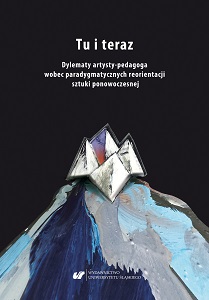Jak stymulować kreatywność przyszłego artysty? Analiza pewnego eksperymentu
How to stimulate creativity of a future artist? The analysis of a certain experiment
Author(s): Aleksandra Giełdoń-Paszek
Subject(s): Education, Fine Arts / Performing Arts
Published by: Wydawnictwo Uniwersytetu Śląskiego
Keywords: didactic experiment; art history; visual studies;questionnaire;
Summary/Abstract: Against the radically changing character of art, an artist-pedagogue faces new challenges connected with the modification of current methods of teaching. This postulate also relates to the sphere of the theory of art, particularly classes in art history held for art degree courses. A certain dissonance can be perceived between expectations, intellectual competence of students and the methodology employed during classes, which originates in Erwin Panofsky’s iconology which demands a thorough preparation from the field of humanities. It seems that a modification of classes is currently needed, which would take advantage of the natural potential for visual sensitivity of artistically gifted young people. Apart from the necessary dose of knowledge, classes on history of art should stimulate creativity of students and teach them how to verbalize their aesthetic experiences. For this purpose, one can use new methods of analysis of works, offered by the so-called New Art History or Visual Culture Study, which would concentrate not on contextual study but on exploring the phenomenon of the work in its visual aspect.For this purpose, experimental classes were held, which used new methods and a questionnaire was later conducted among students. A similar questionnaire was conducted on traditional classes which were held as part of the history of art block. As a result of the questionnaire, it turned out that the new method – a compilation of approaches to art offered by the iconic method, hermeneutics, the method of studying visual materials created by Gillian Rose, the “good eye” theory of Irit Rogoff or considering art in literary context – was accepted by students and had more supporters than the previously employed one (the questionnaire results are attached in the supplement).
Book: Tu i teraz. Dylematy artysty-pedagoga wobec paradygmatycznych reorientacji sztuki ponowoczesnej
- Page Range: 183-198
- Page Count: 16
- Publication Year: 2019
- Language: Polish
- Content File-PDF

